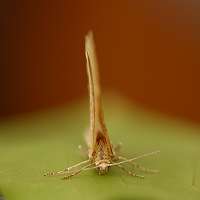Dingy Shell (Euchoeca nebulata)
The Dingy Shell is one of the easiest species to identify. It is sandy brown and always rests with the wings fully closed. On the brownish underside of the wings are a few darker lines, but you don't need these to identify this Geometer. The wingspan is 20 to 23 mm, meaning it is not very variable in size.
From late May the eggs are deposited on the only foodplant known in Britain (Alder). The first caterpillars usually appear in early July. They are yellowish green and often have a broad dark dorsal line, often blocked. They feed till the end of September. Then they will find a good spot in mosses on tree trunks, branches or on the ground and will pupate. The pupa overwinters. The larvae are not very big, for the length usually doesn't exceed 18 mm. On the continent the caterpillars are found on Birch as well as on Alder.
In Britain the Dingy Shell flies in just one generation in July and August. In nearby parts of the continent it flies in two generations, starting in early May. It is regularly seen active during the day and may even visit flowers in garden and parks during sunshine. Is easily disturbed when resting. Comes to light, but in very small numbers only. A species to be found particularly in damp areas in England and Wales. Has a similar habitat on the continent. Is never found in great numbers, neither in Britain, nor on the continent.
The Dingy Shell is one of the easiest species to identify. It is sandy brown and always rests with the wings fully closed. On the brownish underside of the wings are a few darker lines, but you don't need these to identify this Geometer. The wingspan is 20 to 23 mm, meaning it is not very variable in size.
From late May the eggs are deposited on the only foodplant known in Britain (Alder). The first caterpillars usually appear in early July. They are yellowish green and often have a broad dark dorsal line, often blocked. They feed till the end of September. Then they will find a good spot in mosses on tree trunks, branches or on the ground and will pupate. The pupa overwinters. The larvae are not very big, for the length usually doesn't exceed 18 mm. On the continent the caterpillars are found on Birch as well as on Alder.
In Britain the Dingy Shell flies in just one generation in July and August. In nearby parts of the continent it flies in two generations, starting in early May. It is regularly seen active during the day and may even visit flowers in garden and parks during sunshine. Is easily disturbed when resting. Comes to light, but in very small numbers only. A species to be found particularly in damp areas in England and Wales. Has a similar habitat on the continent. Is never found in great numbers, neither in Britain, nor on the continent.





